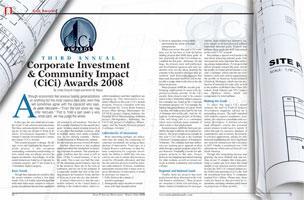
 Although economists feel anxious basing generalizations on anything but the most copious data sets, even they will sometimes agree with the classicist who says, ex pede Herculem—“From the foot alone we may infer Hercules.” That is, from a part (even a very small part), we may judge the whole.
Although economists feel anxious basing generalizations on anything but the most copious data sets, even they will sometimes agree with the classicist who says, ex pede Herculem—“From the foot alone we may infer Hercules.” That is, from a part (even a very small part), we may judge the whole.
In this case, the very small part is a sample of just 31 site selection announcements. But these announcements make a revealing set, for they are all part of Trade & Industry Development magazine’s Third Annual Corporate Investment & Community Impact (CiCi) Awards.
This awards program is unique. By design, it not only highlights the largest corporate projects, it also recognizes outstanding community-transforming efforts, which may not always involve the largest investments. Accordingly, 16 of the award winners are found in a Corporate Investment category, and 15are found in a Community Impact category.
Basic Trends
Though they represent an exclusive few, the award winners confirm a few basic trends. First, it is widely acknowledged that individual states must compete to win corporate investments that promise significant job creation or job retention. This fact of life is amply illustrated in this awards program. In many award-winning projects, it is very plain that multiple locations, often in multiple states, were under consideration. In one extreme example – Medco Health Solutions in Whitestown, Indiana—the site selection process covered 48 states!
Another observation is that southern states have been the trendsetters in attracting corporate investment. This awards program confirms that this trend is still in force. Of the 31 award winners, 17 are in the south. This is just over half the total. Of the remaining award winners, nine are in the midwest, three are in the west or southwest, and two are in the northeast. It is especially notable that four of the winning projects are located in Texas, and two of those are in just one city, San Antonio.
A related observation is that the automobile industry in the United States is shifting to the southern states, where so-called transplants (and their suppliers) are springing up. This observation is certainly reflected in this year’s CiCi awards program. Projects consistent with this trend include the Toyota North America project (Blue Springs, Mississippi), the GETRAG project (Tipton, Indiana), the Hyundai Motor Manufacturing Alabama project (Montgomery, Alabama), the PACCAR project (Columbus, Mississippi), and the Sewon Precision project (LaGrange, Georgia)
Laboratories of Innovation
More interesting perhaps, are indications that the states, by competing for corporate investment, are acting as laboratories of innovation. Years ago, in a Federal Reserve conference on state-by-state competition for corporate investment, the ability to fulfill this role was cited as one way to ensure that resources would be efficiently allocated, and that the site selection process would be a positive-sum endeavor. However, conference participants stressed that if states were to act as laboratories of innovation, it would be necessary for states to:
1. Fully disclose the content of incentive packages
2. Strategically target incentives toward areas with high unemployment
3. Invest in upgrading worker skills and meeting the needs of in-state entrepreneurs.
When you review this year’s CiCi winners, you do not have to look far before finding projects that fulfill these goals. In fact, practically all of the CiCi winners accomplish the first goal—disclosure. By and large, the projects were well publicized, and development agencies and state authorities were not shy about detailing the contents of the incentive packages they assembled. Such disclosure suggests that states and interested observers will be better able to judge what works best in the site selection process.
Many projects fulfill the second goal – bringing employment to areas with depressed economic activity. In the CiCi awards, these projects tend to be concentrated in the Community Impact category, but examples are found in the Corporate Investment category, too. For example, the Madras Integrated project, in Lenoir, North Carolina, will help an area hurt by the loss of furniture and textile jobs. And the Allegheny Technologies project, in Rowley, Utah, will bring jobs to a community where most residents must commute to other towns to find employment.
Several projects fulfill the third goal, primarily through workforce development initiatives. The most conspicuous example in this year’s CiCi line-up is the Eastman Chemical Company project, in Kingsport, Tennessee. The company and state authorities are teaming up to upgrade worker skills through a special program called Project Reinvest. Potentially a model for subsequent projects in the state, Project Reinvest encompasses specialized training for older workers, as well as revised curricula at nearby community and technical colleges.
Regional and National Goals
Finally, there are projects that meet goals beyond those discussed in the Federal Reserve conference. These projects are intended to build self-enriching industry clusters (foundations for next-generation, high-technology industry), exploit unique local resources and achieve important national goals. Projects that achieve these goals are well represented in this year’s CiCi awards. But perhaps a special word needs to be said about achieving national goals. Few such goals are more important than achieving energy independence. For projects that deliver progress toward this goal, review the profile on TransCarbon/Faustina (Convent, Louisiana), which cites the use of alternative fuels and carbon sequestration; the profile on Hemlock Semiconductor (Hemlock, Michigan), which cites the production of materials for solar cells; as well as the profiles on Molded Fiber Glass (Aberdeen, South Dakota) and TPI Composites (Newton, Iowa), which cite components for wind turbines.
Making the Grade
To select this year’s CiCi award winners, the staff of Trade & Industry Development magazine carried out a painstaking process. The staff consulted with industry experts, academics, journalists, site selection consultants and economic developers. It defined relevant (and stringent) criteria that potential award winners would need to satisfy. It sifted through its extensive database of communities and economic developers. It solicited applications, asking for submissions highlighting the most significant site selection transactions that took place in 2007. Finally, it scrutinized over 1,000 submissions, which arrived from all over North America.
Though this winnowing process was grueling, the most difficult task was settling on just 31 winners. But it was gratifying to realize just how much this small sample of site selection activity achieved. In total, the 2007 CiCi winners helped create 24,693 jobs and retain 22,213 jobs. And the investments from these 31 companies reached $16.1 billion. (Please note: these totals are based on data provided by respondents, including estimates partly based on projections of future growth.)

